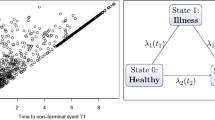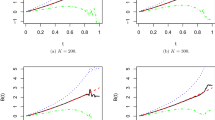Abstract
In the semi-competing risks situation where only a terminal event censors a non-terminal event, observed event times can be correlated. Recently, frailty models with an arbitrary baseline hazard have been studied for the analysis of such semi-competing risks data. However, their maximum likelihood estimator can be substantially biased in the finite samples. In this paper, we propose effective modifications to reduce such bias using the hierarchical likelihood. We also investigate the relationship between marginal and hierarchical likelihood approaches. Simulation results are provided to validate performance of the proposed method. The proposed method is illustrated through analysis of semi-competing risks data from a breast cancer study.
Similar content being viewed by others
References
Aalen O, Borgan O, Gjessing HK (2008) Survival and event history analysis. Springer, New York
Andersen PK, Klein JP, Knudsen K, Palacios RT (1997) Estimation of variance in Cox’s regression model with shared gamma frailties. Biometrics 53:1475–1484
Barker P, Henderson R (2005) Small sample bias in the gamma frailty model for univariate survival. Lifetime Data Anal 11:265–284
Breslow NE (1974) Covariance analysis of censored survival data. Biometrics 30:89–99
Chen YH (2012) Maximum likelihood analysis of semicompeting risks data with semiparametric regression models. Lifetime Data Anal 18:36–57
Engel E, Keen A (1996) Discussion of Lee and Nelder’s paper. J R Stat Soc Ser B 58:656–657
Fan J, Li R (2002) Variable selection for Cox’s proportional hazards model and frailty model. Ann Stat 30:74–99
Fine JP, Jiang H, Chappell R (2001) On semi-competing risks data. Biometrika 88:907–919
Fisher B, Costantino J, Redmond C et al (1989) A randomized clinical trial evaluating tamoxifen in the treatment of patients with node-negative breast cancer who have estrogen receptor-positive tumors. N Engl J Med 320:479–484
Fisher B, Dignam J, Bryant J et al (1996) Five versus more than five years of tamoxifen therapy for breast cancer patients with negative lymph nodes and estrogen receptor- positive tumors. J Natl Cancer Inst 88:1529–1542
Gu MG, Sun L, Huang C (2004) A universal procedure for parametric frailty models. J Stat Comput Simul 74:1–13
Ha ID, Lee Y (2003) Estimating frailty models via Poisson hierarchical generalized linear models. J Comput Graph Stat 12:663–681
Ha ID, Lee Y, Song JK (2001) Hierarchical likelihood approach for frailty models. Biometrika 88:233–243
Ha ID, Lee Y, Pawitan Y (2007) Genetic mixed linear models for twin survival data. Behav Genet 37:621–630
Ha ID, Noh M, Lee Y (2010) Bias reduction of likelihood estimators in semiparametric frailty models. Scand J of Stat 37:307–320
Ha ID, Sylvester R, Legrand C, MacKenzie G (2011) Frailty modelling for survival data from multi-centre clinical trials. Stat Med 30:2144–2159
Ha ID, Jeong J-H, Lee Y (2017) Statistical modelling of survival data with random effects: h-likelihood approach. Springer, Singapore
Heize G, Schemper M (2001) A solution to the problem of monotone likelihood in Cox regression. Biometrics 57:114–119
Lawless JF (2003) Statistical models and methods for lifetime data, 2nd edn. Wiley, New York
Lee Y, Nelder JA (1996) Hierarchical generalized linear models (with discussion). J R Stat Soc Ser B 58:619–678
Lee Y, Nelder JA (2001) Hierarchical generalised linear models: a synthesis of generalised linear models, random-effect models and structured dispersions. Biometrika 88:987–1006
Lee Y, Nelder JA (2009) Likelihood inference for models with unobservables: another view (with discussion). Stat Sci 24:255–293
Lee KH, Haneuse S, Schrag D, Dominici F (2015) Bayesian semiparametric analysis of semicompeting risks data: investigating hospital readmission after a pancreatic cancer diagnosis. J R Stat Soc Ser C 64:253–273
Lee Y, Nelder JA, Pawitan Y (2017) Generalised linear models with random effects: unified analysis via h-likelihood, 2nd edn. Chapman and Hall, Baca Raton
Neyman J, Scott EL (1948) Consistent estimates based on partially consistent observations. Econometrica 16:1–32
Noh M, Lee Y (2007) REML estimation for binary data in GLMMs. J Multivar Anal 98:896–915
Ripatti S, Palmgren J (2000) Estimation of multivariate frailty models using penalized partial likelihood. Biometrics 56:1016–1022
Self SG, Liang KY (1987) Asymptotic properties of maximum likelihood estimators and likelihood ratio tests under nonstandard conditions. J Am Stat Assoc 82:605–610
Stram DO, Lee JW (1994) Variance components testing in the longitudinal mixed effects model. Biometrics 50:1171–1177
Therneau TM, Grambsch PM (2000) Modelling survival data: extending the Cox model. Springer, New York
Therneau TM, Grambsch PM, Pankratz VS (2003) Penalized survival models and frailty. J Comput Graph Stat 12:156–175
Tierney L, Kadane JB (1986) Accurate approximations for posterior moments and marginal densities. J Am Stat Assoc 81:82–86
Varadhan R, Xue QL, Bandeen-Roche K (2014) Semicompeting risks in aging research: methods, issues and needs. Lifetime Data Anal 20:538–562
Xu J, Kalbfleisch JD, Tai B (2010) Statistical analysis of illness-death processes and semicompeting risks data. Biometrics 66:716–725
Zhang Y, Chen MH, Ibrahim JG, Zeng D, Chen Q, Pan Z, Xue X (2014) Bayesian gamma frailty models for survival data with semi-competing risks and treatment switching. Lifetime Data Anal 20:76–105
Acknowledgements
Dr. Ha’s research was supported by Basic Science Research Program through the National Research Foundation of Korea (NRF) funded by the Ministry of Education (No. NRF-2015R1D1A3A01015663). Dr. Xiang’s research was supported in part by the Singapore MOE AcRF (MOE2013-T2-2-118). Dr. Jeong’s research was supported in part by National Institute of Health (NIH) grants 5-U10-CA69651-11. Dr. Lee’s research was supported by an NRF grant funded by Korea government (MEST) (No. 2011-0030810).
Author information
Authors and Affiliations
Corresponding author
Additional information
Publisher's Note
Springer Nature remains neutral with regard to jurisdictional claims in published maps and institutional affiliations.
Electronic supplementary material
Below is the link to the electronic supplementary material.
Appendix
Appendix
1.1 Appendix A: Marginal-likelihood estimation procedure
For gamma frailty models with \(E(u_{i})=1\) and var\((u_{i})=\alpha \), we have an explicit marginal likelihood as follows. Since the second term of h-likelihood in (8) under the gamma frailty is given by
with \(c(\alpha )=-\log \Gamma (\alpha ^{-1}) -\alpha ^{-1} \log \alpha \), from (8) and (15) we have that
where \(\delta _{i+}= \delta _{i1} + \delta _{i2}\) and \(\mu _{i+}=\sum _{j=1}^{3} \mu _{ij}\) with
In fact, the marginal likelihood (A.1) is the same as that of Xu et al. (2010).
Under the gamma frailty, the score equations for \(\beta \) are given by
In particular, the solutions of \(\partial m/\partial \lambda _{0jk_j}=0~(j=1,2,3)\) lead to closed forms:
where \({\tilde{u}}_i=(\alpha ^{-1}+\delta _{i+})/(\alpha ^{-1}+\mu _{i+})\). We see that the score equations of \((\beta , \lambda _{0j})\) in (A.2)–(A.4) and (A.5) are extensions of those in the shared gamma frailty models (Andersen et al. 1997). Finally, the score equation for the frailty parameter \(\alpha \) is given by
Then the estimates of fixed parameters \((\beta ,\alpha , \lambda _{0})\) can be obtained using a numerical iterative method such as the Newton-Raphson method. Note that the maximum likelihood estimating equations, \(\partial m/\partial (\beta ,\alpha , \lambda _{0})=0\), by Xu et al. (2010) are equivalent to \(\partial m^{*}/\partial (\beta ,\alpha )=0\), where \(m^{*}\) is the profile marginal likelihood in (16).
1.2 Appendix B: Comparison of h-likelihood with marginal likelihood
We assume that \(\alpha \) is known. Recall that given \((\beta , v)\), the score equations \(\partial h/\partial \lambda _{0jk_j}=0~(j=1,2,3)\) provide the non-parametric maximum h-likelihood estimators in Sect. 2.2, i.e.
The maximum h-likelihood estimating equations for \(\beta \), under the gamma frailty, become
From
we have that
which also becomes \(E(u_i|y_i^o)\) because the conditional distribution of \(u_i\) given the observed data \(y_i^o=(y_{i1}, y_{i2}, \delta _{i1}, \delta _{i2})\) is gamma. Here \(\delta _{i+}=\delta _{i1}+\delta _{i2}\) and \(\mu _{i+}=\mu _{i1} +\mu _{i2}+\mu _{i3}\). From (12) we see that the estimating Eqs. (B.1)–(B.3) with (B.4) are equivalent to the estimating Eqs. (A.2)–(A.4) with (A.5), given by
Accordingly, the maximum h-likelihood (MHL) estimator for \(\beta \) given \(\alpha \) is the same as the marginal maximum likelihood (ML) estimator as shown in the standard gamma frailty models (Ha et al. 2001; Ha and Lee 2003). Note, however, that both methods give different estimators for \(\alpha \).
The marginal likelihood does not often have an analytic form (e.g. log-normal frailty model), so that the natural approach to the maximum likelihood estimator (MLE) is to use the EM treating the random effects as missing data. Below we present the comparison of the proposed h-likelihood method with the EM method for obtaining the MLE. The EM equations for fixed parameters \(\theta \) can be expressed via the h-likelihood as follows:
which is equivalent to the ML equations, i.e. \(\partial m/\partial \theta =0\) (Lee and Nelder 1996; Engel and Keen 1996; Ha et al. 2001).
In the semi-competing risks frailty models (5)–(7), the EM equations for \((\beta ,\alpha )\) are given by
Here, the EM equations of the baseline hazards \(\lambda _{0jk_j}\) are given by
which lead to
Following Ha et al. (2001), in the gamma frailty models, given \(\alpha \) the MHL equations for \(\beta \)
with (B.4) are equivalent to the EM equations
since \(E(u_{i} |y_i^{o})\) becomes \({\tilde{u}}_{i}\) in (A.5) and thus \({{\widetilde{\lambda }}}_{0jk_j}^{*}\) is identical to \({\tilde{\lambda }}_{0jk_j}\) in (A.5) as well as to \({\widehat{\lambda }}_{0jk_j}\). However, in general the EM may be difficult to apply because the conditional distribution of \(u_{i}\) given \(y_i^{o}\) is not trivial to be evaluated. For example, in the log-normal frailty with \(v_{i}=\log u_{i} \sim N(0, \alpha )\), the EM equation for \(\beta _1\) is given by
where
Note here that the computation of \( E(u_i|y_{i}^{o})\) requires a numerical integration.
Rights and permissions
About this article
Cite this article
Ha, I.D., Xiang, L., Peng, M. et al. Frailty modelling approaches for semi-competing risks data. Lifetime Data Anal 26, 109–133 (2020). https://doi.org/10.1007/s10985-019-09464-2
Received:
Accepted:
Published:
Issue Date:
DOI: https://doi.org/10.1007/s10985-019-09464-2




